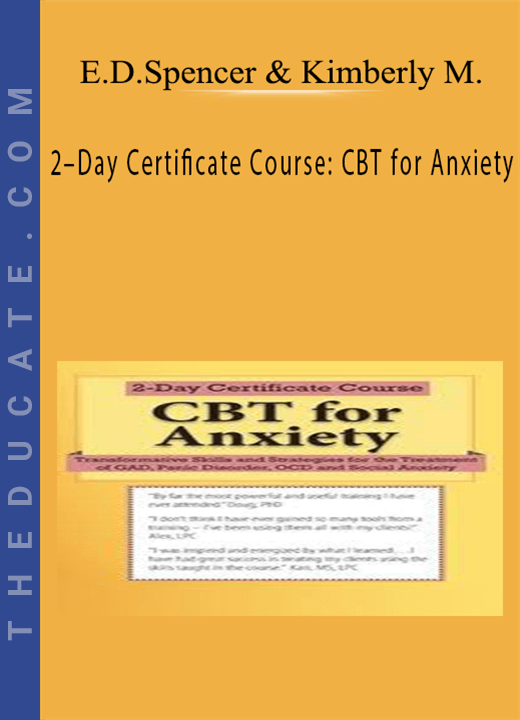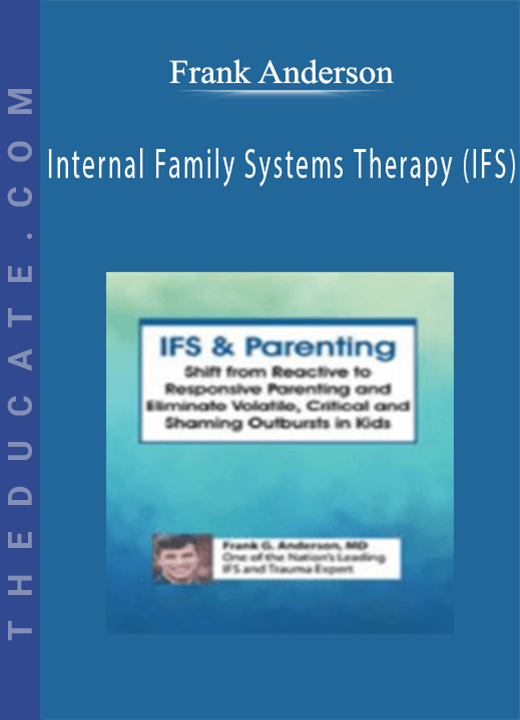Description
2-Day Certificate Course: CBT for Anxiety: Transformative Skills and Strategies for the Treatment of GAD, Panic Disorder, OCD and Social Anxiety – Elizabeth DuPont Spencer & Kimberly Morrow
Do you feel overwhelmed by the severity of your client’s anxiety symptoms? Does their need to seek reassurance and perform compulsions prevent them from moving forward in therapy? You are not alone if you find your clients experiencing the same symptoms after several therapy sessions, if they get stuck on the “why’s” of anxiety or if they are unable to take meaningful action against their anxiety.
Watch this intensive two-day live webcast to learn specific ways to climb over these obstacles in therapy and gain confidence in your ability to treat the most symptomatic, anxious clients on your caseload.
Start seeing real results with cutting edge CBT interventions that give you:
- Ways to help clients face their triggers and change their relationship with fear
- Strategies to manage your own anxiety about treating your anxious clients
- Methods to use exposure therapy in meaningful, successful ways
- Specific strategies for Panic Disorder, phobias, OCD and Social Anxiety
Packed with videos, case examples, and opportunities to practice, this two-day live webcast is designed for clinicians who want to start seeing real results with anxiety clients. Learn CBT with Exposure and Response Prevention in a positive, supportive environment and walk away with strategies you can use the very next day!
Don’t miss this opportunity to grow your confidence and your practice while helping your clients get their lives back!
- Educate and socialize anxious clients to the CBT session structure in order to achieve positive clinical outcomes.
- Assess for and diagnose each DSM-5® anxiety disorder, including Obsessive-Compulsive Disorder, Generalized Anxiety Disorder, Social Anxiety Disorder, Separation Anxiety Disorder, PANS/PANDAS, and Panic Disorder.
- Implement Exposure and Response Prevention (ERP) techniques to increase your client’s success.
- Utilize strategies that help family members become anxiety “coaches” for the client.
- Formulate interventions for challenging automatic negative thoughts in clients who have been diagnosed with anxiety.
- Identify when it is clinically appropriate to use extreme exposure interventions with clients.
- Demonstrate the use of interoceptive therapy for treating panic in clients.
- Explain the purpose of utilizing paradoxical exposures when treating social anxiety.
- Apply knowledge about Generalized Anxiety Disorder to learn how to prevent fears about the future from interfering with quality of life.
- Utilize play-based exposure interventions for the treatment of anxiety in children.
- Implement Exposure and Response Prevention techniques to reduce symptoms of Obsessive-Compulsive Disorder.
- Formulate treatment termination and relapse prevention plans with clients.
Getting Started: How to Optimize the Early CBT Sessions
- Principles of CBT – Establish roles and goals
- How to socialize your client to the CBT Session structure
- Get your client to do homework
- What not to do (reassurance, rabbit hole)
- Tools for goal setting
- Begin with the end in mind: Termination considerations
Assessment and Treatment Planning: Set the Stage for Successful Treatment
- Diagnosis – why it’s important
- Key questions to ask at intake
- Assessment forms – where to find them
- Teach your clients to use a notebook
- Using a SUDS scale
Anxiety and the Brain: What Every Client Needs to Know
- Why this is a pivotal point of treatment
- Simple ways to teach clients about anxiety and the brain
- The role of avoidance and safety behaviors
- Medication-what is helpful and what is not
The Art of Exposure and Response Prevention (ERP)
- The role of the clinician
- Teach clients to ride the wave of anxiety
- Create a fear hierarchy using SUD scales
- How to set up an exposure
- Working with resistance to exposure
- What NOT to do and why
Cognitive Therapy: Change the Way Clients Think about Thinking
- Empower clients to choose how to interpret their thoughts
- Utilize values clarification to motivate change
- Challenge distortions and core beliefs that get in the way of change
- The role of mindfulness in anxiety treatment
Family Involvement: Teach Loved Ones to be a Part of the Solution
- Help families learn healthier ways to talk back to anxiety
- Teach how to respond without reassuring
- Challenge loved ones to face their own fears
Phobias and OCD: Exposure and Response Prevention in Action
- Identify OCD’s tricks
- Strategies for the most common phobias (heights, spiders, small spaces and more!)
- How to get comfortable with extreme exposures
- Vomit phobia, fear of harm, contamination, obsessive thoughts, sexual obsession
- Identify your own obstacles to successful ERP
- Get out of the office!
- Using scripts
- Demonstrations and practice
Panic Disorder: Interoceptive Exposure Techniques That Work
- Why deep breaths aren’t enough
- Practice breathing to increase CO2
- Identify the fear in panic
- How to induce symptoms of panic to build tolerance of discomfort
- Strategies for choosing a panic behavior to replicate
Social Anxiety: Paradoxical Treatment Interventions that Get Results
- Going after embarrassment
- Tools to practice mindfulness during conversations
- Build clients’ “I can handle it” muscle
- Help clients improve insight about their fears
- How to remove safety behaviors in social situations
Generalized Anxiety Disorder (GAD) and Worry: Helping Our Clients Live in the Present
- Overcoming the fear that “I won’t be able to handle it”
- Tools that teach clients how to handle distressing thoughts/feelings
- Utilize mindfulness/living in the present
- Write worry scripts, assign time for worry, chase after worry
Kids with Anxiety: Playing with Fear
- Special considerations when working with children
- School refusal, contamination, bad thoughts, PANS/PANDAS
- Add play to your treatment plan
- Strategies for age appropriate interventions
- Teach kids to talk back to their fears
- How to handle parent resistance/therapy interference
Termination and Relapse Prevention
- Why is this a critical point in therapy
- Develop a client wellness plan that sticks
- Help clients identify red flags
- Teach clients to do ongoing exposures
- Establish a plan for when to return to therapy
- Risks and limitations of the research
Tag: 2-Day Certificate Course: CBT for Anxiety: Transformative Skills and Strategies for the Treatment of GAD, Panic Disorder, OCD and Social Anxiety – Elizabeth DuPont Spencer & Kimberly Morrow Review. 2-Day Certificate Course: CBT for Anxiety: Transformative Skills and Strategies for the Treatment of GAD, Panic Disorder, OCD and Social Anxiety – Elizabeth DuPont Spencer & Kimberly Morrow download. 2-Day Certificate Course: CBT for Anxiety: Transformative Skills and Strategies for the Treatment of GAD, Panic Disorder, OCD and Social Anxiety – Elizabeth DuPont Spencer & Kimberly Morrow discount.







7 reviews for 2-Day Certificate Course: CBT for Anxiety: Transformative Skills and Strategies for the Treatment of GAD, Panic Disorder, OCD and Social Anxiety – Elizabeth DuPont Spencer & Kimberly Morrow
There are no reviews yet.